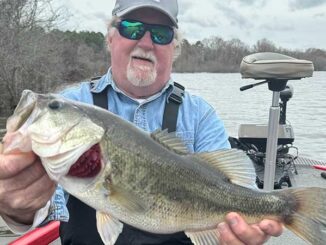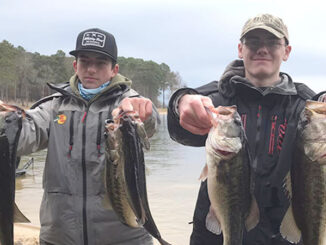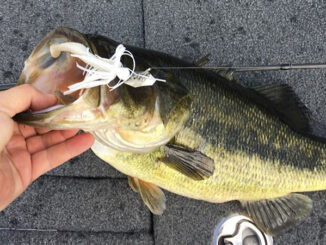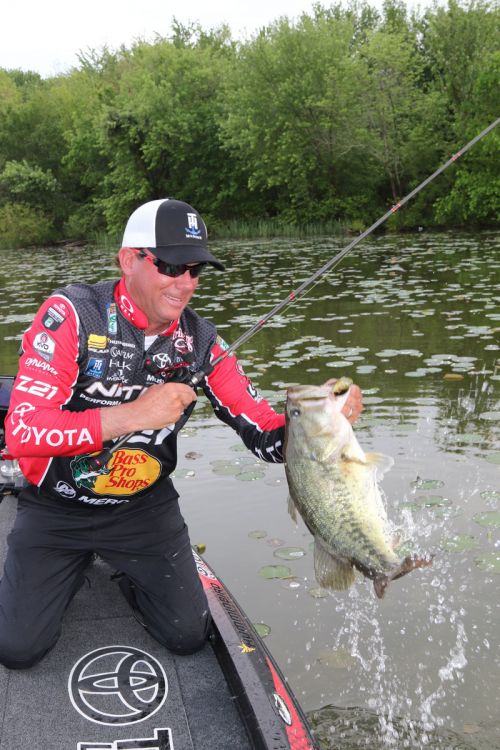 Largemouth bass know they’re vulnerable when they move shallow. Employ these tactics this spring, and you just might land the lunker of a lifetime.
Largemouth bass know they’re vulnerable when they move shallow. Employ these tactics this spring, and you just might land the lunker of a lifetime.
Big fish moving shallow — seems like a can’t-miss opportunity with home run potential, right?
Yes, the largemouth bass spawn can certainly bring the fireworks, but if you think you can just stick your nose into a creek or shallow pocket, flip a Texas-rigged plastic into one of those smoothed-out white spots and yank out a chunky one, think again.
Is it ever that easy? Sure. We’ve all heard the glory tales of “ready” fish and one-cast wonders. But if that were always the case, each spring tournament would see every angler weighing-in 20-plus sacks.
Truth be told, those lightning strikes are the exception to the rule: Plan on working long and hard for your spawn bites. These fish realize the vulnerability of their shallow migration and make no mistake; they don’t miss anything. You have to play their game; get inside their wheelhouse and leverage their preferences, tendencies and anxiety points.
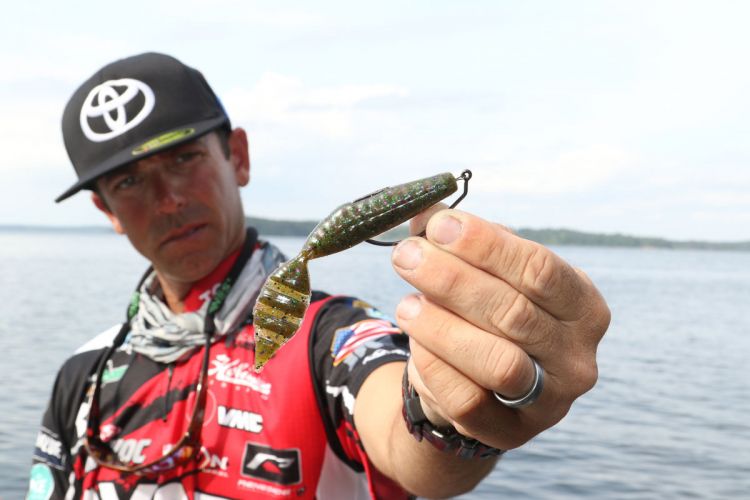
The exact formula varies day to day; sometimes fish to fish, as the variables of conditions, habitat and fishing pressure constantly shuffle the deck.
For example, say it’s an overcast day and you luck into an established bed fish under a laydown where no one else has found her. That fish will likely display a higher level of comfort and, therefore, more aggression than a bass bedding in shallow clear water on an open bank with sunny, clear conditions that allow her to spot you as soon as you roll out of bed that morning.
We can’t cover everything in one conversation, but the following pointers could help you land a lunker during the spawn:
Tantalizing bed baits
There are times when anything that lands in or near a bass bed gets hammered, but oftentimes, it’s more of a chess match. Watch the fish’s response; does she lazily reposition, as if more annoyed than defensive? Or, does she hover directly over the bait, frequently changing angles in noticeably rising aggression?
If you want the latter, try these strategies:
Super-size it: Anytime you get close to a bed fish and she holds her ground, she’s committed and ready to defend. She’ll let the smaller male handle the light work, but serious threats earn mama’s wrath.
To red line her rage, pitch a 7-inch (or larger) lizard, creature bait, a big worm or a jumbo tube like the 6-inch Gitzit Super Tube or 7-inch Mizmo Ish Tube. It’s a yes-or-no deal, but a fish that doesn’t run from a whopper bait will almost always try to kill it.
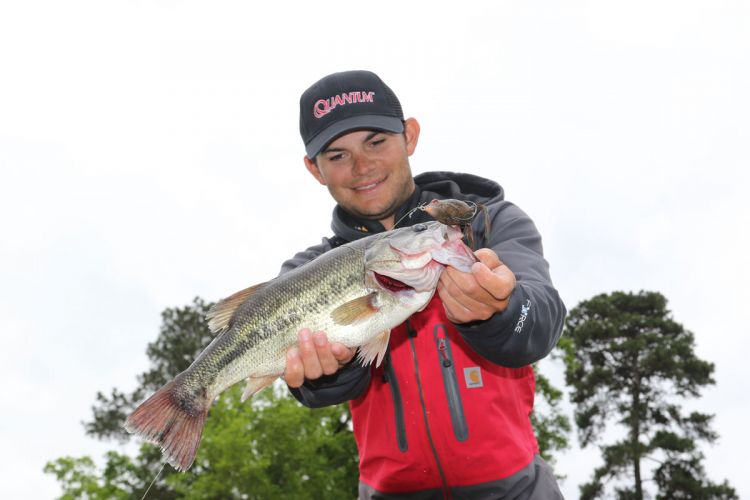
Sidework: Nothing irritates a bass like a nest-raiding bluegill. Color choices like green pumpkin, black and blue, etc. can help you mimic the appearance, but Mike Iaconelli has a unique strategy for making his Berkley Havoc Devil’s Spear resemble the bluegill profile.
“A shad has a very thin, sleek profile; but a bluegill has more of an oval profile, so when I’m trying to imitate a bluegill, I’ll purposely rig that Devil’s Spear sideways (hook coming through the thin side) on a VMC weedless swimbait hook, instead of flat,” he said. “This changes the profile in the water.
“The Devil’s Spear, as a flipping bait, is what I call an ‘in-and-out bait.’ As it falls to the bottom, you pretty much just have tail movement. When you rig it sideways, you get the tail movement and you get a side-to-side shimmy almost like a soft stick bait.”
Paint Job: When a bed fish plays hard-to-get, subtle details like color accents can close the deal. Bassmaster Elite pro Gary Klein often touches up the pincers of his craw baits, but warns against overdoing it. Never dunk bed fish baits in dye; rather, use a Q-tip or the edge of a paper towel to dab just the tips.
Nifty trick: Rub the tip of a Yamamoto Senko between your fingers and as salt crystals exude, watch the bait color change. Instant accent ….
Hop to it
What gives a bass more anxiety than an intruder standing in its bed? A bad guy lurking overhead. Think about it, a bass can keep a close eye on anything in its territory and attack if the intruder looks like it’s threatening. But a topwater frog offers the doubly enticing element of a protein-rich meal for fish that have just moved up, with the element of unpredictable peril for established fish.
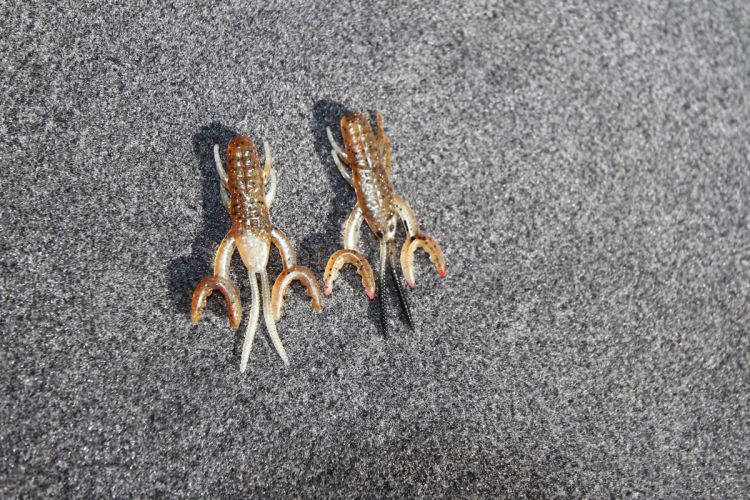
“A frog is even better during the spawn than the prespawn because you can keep it over the top of them for a long time,” said Bassmaster Elite pro Kevin VanDam. “A lot of times, bass spawn on lily pad roots, so shallow pads are a great place to catch them with a frog.”
Favoring natural frog patterns with brighter colors like yellow and chartreuse, VanDam mostly throws the traditional pointed nose Strike King KVD Sexy Frog, as it comes through pads, grass, etc. with minimal resistance. However, he’ll also keep the noisy KVD Popping Perch — a frog style bait with a concave face and bream-like fins instead of fringe legs — on standby.
“If the water is clear, I think a standard frog is hard to beat; it doesn’t make as much commotion and you can still make it walk really well,” VanDam said. “But if the water is more stained or if you have a little wind, the popping style frog makes more noise and you can work it faster.
“With both baits, you can make them move back and forth without moving a lot of water with subtle twitches.”
Frogs will serve you well for searching broad areas and probing those where you can’t get a good line of sight. Example: When fish spawn around trees, docks, bushes, etc. If fish are just arriving, they may or may not eat, but they’ll definitely attack. Even if they only blow up at it, identifying where they are gives you a reference for targeted presentations.
Stay back
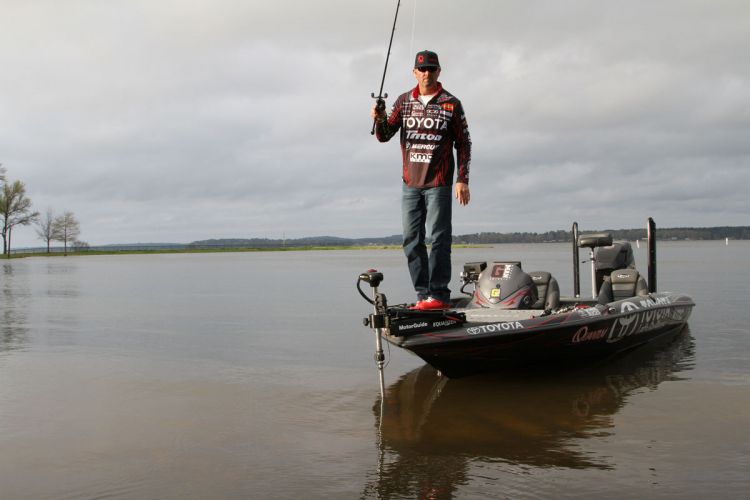
The politics of proximity tell us that if you can see the fish, she’s probably already seen you. That’s particularly important in clear, still conditions when bedding bass are on high alert.
Helpful moves include standing on the trolling motor mount. Believe it or not, gaining a handful of inches in altitude can make a world of difference by raising your line of sight. Magnifying this angle increase over the distance to your target yields a significant sight advantage.
Also critical is blocking out peripheral glare. Wrap style sunglasses do some of this, but hooded sweatshirts, jerseys or lightweight performance sun shirts like the new SIMMS SolarFlex Armor Shirt can aid the effort. Pull the hood over your hat to effectively block all light intrusion and create an unhindered vision lane.
Hard-headed

We tend to think about soft baits for beds — generally Texas-rigs, jig trailers and dropshots — but don’t overlook your treble hook lures. Similar to a frog’s overhead intrusion, try using a suspending jerkbait in open water scenarios like a clear bank to hold a bait mid-depth and make the fish play the deadly staring game.
If you really want to push the big gal’s buttons, upsize your front treble so the bait hangs nose-down in a taunting posture.
The color of success
Braided line is often preferred for bed fishing for the immediate response of its zero-stretch composition. However, the thinner diameters can be difficult to see from a distance when dim conditions challenge your vision. You can’t afford to miss the subtle line movement when a fish you can’t clearly see picks up your bait, so use a permanent marker to add 1-inch stripes a few inches apart for a visual aid that clearly stands out, even in low light scenarios.
Get pushy with spawners
Your trolling motor is essential for easing in and out of spawning areas, but when matching wits with skittish bed fish, even low power can ice the game. And if you’re working water with lower visibility and you make a hard move on the troller, you might blow out a spot before you see another bed fish.
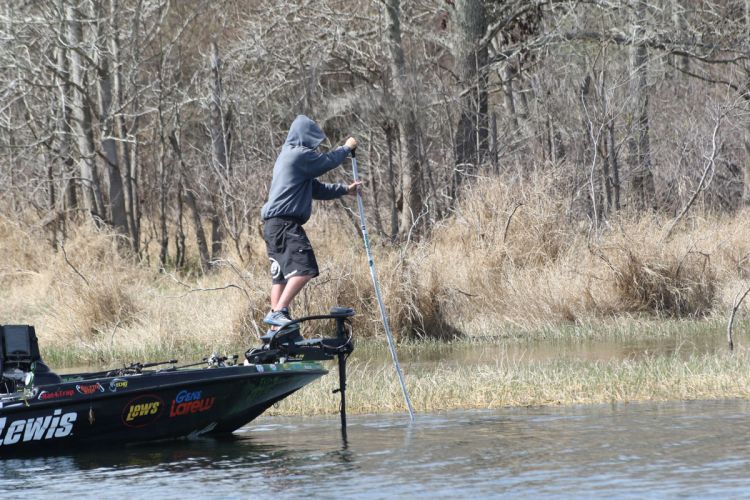 For this fine detail work, a push pole provides an option for making minor advancements without the noise and surge of a trolling motor. Here are a few points to consider:
For this fine detail work, a push pole provides an option for making minor advancements without the noise and surge of a trolling motor. Here are a few points to consider:
Easy in, easy out — Even though the push pole enters the water behind your position, it can still spook fish if it splashes on the entry or exit. Smooth, measured movements are what you want.
Bottom impacts — Considering that fish spawn over hard bottom, you have to consider how sound echoes below the surface. Think swimming pools: Duck your head below the surface and every foot step sounds like thunder. So, how do you think Mama Bed Fish is going to handle the thump of an awkwardly-placed push pole? Not well; not well, at all.
Design options — For space management, bass pros typically use multi-part or telescoping push poles that stow out of the way behind the seats. Budget-conscious anglers might make one out of a wooden dowel or heavy gauge PVC. If you go with wood, durable tape (athletic, electrical, duct) makes a nice slip-resistant, splinter-free hand grip.
